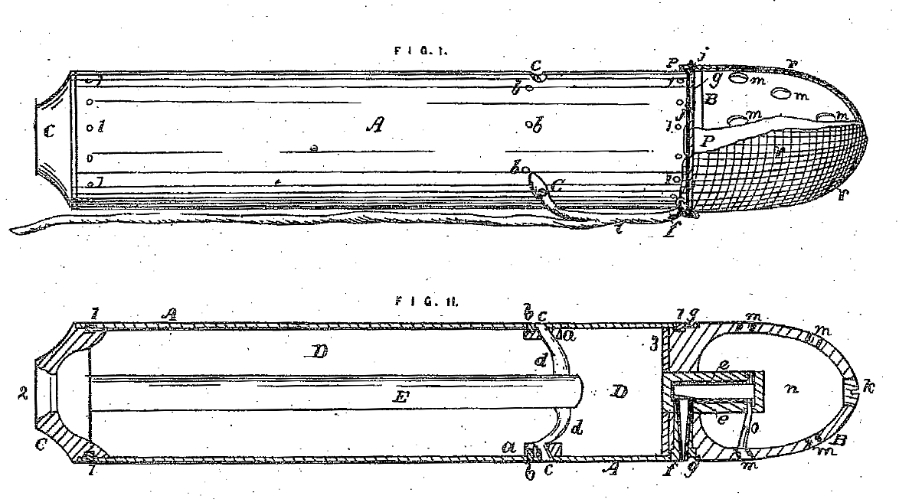It is no secret to anyone who has read Lincoln: The Fire of Genius that Abraham Lincoln was a fan of advanced weaponry during the Civil War. He would routinely entertain inventors promoting their new device “that would surely end the war tomorrow.” Some of those devices were rockets, and one of them almost killed Lincoln.
On this date in 1864, Lincoln was joined by Assistant Secretary of the Navy Gustavus Fox and Senator Orville H. Browning on an excursion from the White House to the Washington Navy Yard. Lincoln frequently visited the Washington Navy Yard to discuss weapons and strategy with Commander John Dahlgren, a like-minded acolyte of technology. On this occasion, according to Browning’s diary, the three men witnessed the “throwing of rockets and signal from six- and twelve-pound guns.” The demonstration went off as planned and no unexpected dangers to the president were evident.
The same cannot be said for another rocket test in late 1862, where Lincoln was perhaps more closely involved than anticipated. This time Lincoln had been joined by Secretary of State William Seward and Secretary of the Treasury Salmon P. Chase on the trip to the Navy Yard, where Dahlgren had planned for them to observe the testing of a Hyde rocket. The Hyde was an improvement of the Congreve rockets that had been used for many decades. It was “red glare” of the Congreve rocket and “bombs bursting in air” that had allowed Francis Scott Key to see “proof through the night that our flag was still there” during the British attack on Fort McHenry in 1814. But the Congreve was little more than a bottle rocket on a stick and unsuitable for the current Civil War. Since then, English inventor William Hale had created a much more advanced rocket using side vents allowing the release of propulsion gases, which caused the rocket to rotate in flight, thus improving its stability, distance, and precision. Hale’s rocket had been introduced in the United States by Joshua Burrows Hyde and received limited use during the Mexican American War of the 1840s. It was an improved version of this newly renamed Hyde rocket that Lincoln and companions were at the Navy Yard to observe.

The initial launching of the Hyde rocket didn’t go as planned. Rather than arcing across the Anacostia River, the rocket exploded in a fury of fire and smoke. Luckily for all present, the rocket had exploded without even leaving the launcher, thus containing most of the shrapnel and no one was injured. Lincoln would return to the White House while the operator, Lt. Commander William Mitchell, investigated the incident. Two days later, Mitchell was ready to try again. This time, Lincoln, Seward, and Chase remained safely ensconced in the White House, which turned out to be a good decision. The Hyde rocket managed to leave the launcher without exploding, but rather than hitting its intended target it flew out of control and landed on the roof of a nearby blacksmith shop, where again luckily it caused no further damage.
At this point the idea was mothballed and Hyde, although patenting it the following year, gave up on the idea. He did, however, contribute to the war effort in other ways, focusing his later efforts on improving smaller guns and cannons with much better success.
Abraham Lincoln would continue to encourage the development of new weapons throughout the war, which I discuss in more depth in Lincoln: The Fire of Genius. As for rockets, they played only a small role in the Civil War and would have to wait for future wars to be further developed into the weapons of mass destruction we use today.
[Photo of Hyde’s 1863 rocket patent, Google patent and Robert Pohl, 2018]

Lincoln: The Fire of Genius: How Abraham Lincoln’s Commitment to Science and Technology Helped Modernize America is available at booksellers nationwide.
Limited signed copies are available via this website. The book also listed on Goodreads, the database where I keep track of my reading. Click on the “Want to Read” button to put it on your reading list. Please leave a review on Goodreads and Amazon if you like the book.
You also follow my author page on Facebook.
David J. Kent is President of the Lincoln Group of DC and the author of Lincoln: The Fire of Genius: How Abraham Lincoln’s Commitment to Science and Technology Helped Modernize America and Lincoln: The Man Who Saved America.
His previous books include Tesla: The Wizard of Electricity andEdison: The Inventor of the Modern World and two specialty e-books: Nikola Tesla: Renewable Energy Ahead of Its Time and Abraham Lincoln and Nikola Tesla: Connected by Fate.










